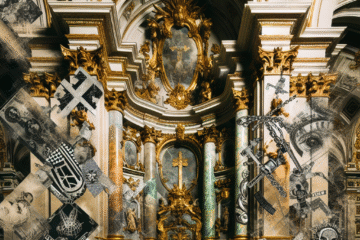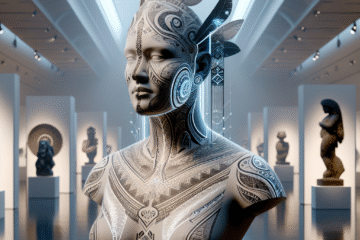
Image title: Pendant mask of Ìyọ́bà Idià
Medium: Ivory, iron, brass, coal, traces of iron oxides
Date: 16th century
Source:
The Met Collection
“
As a water bead on a lotus leaf, as water on a red lily, does not adhere, so the sage does not adhere to the seen, the heard, or the sensed.
”
— The Buddha
Not Just Ink on Skin: Tattooing as Living Sculpture Across Cultures
Introduction: Skin as Canvas, Pain as Chisel
The human body has long served as a vehicle for artistic expression. From body painting in tribal rituals to scarification and piercings, transforming the flesh into art has deep roots across cultures and ages. Among these bodily art forms, tattooing stands out as a unique—and ancient—practice that fuses the pain of endurance with the permanence of creative expression. This essay explores tattooing not merely as decoration, but as a form of living sculpture—an ever-evolving medium that sculpts identity, narrates memory, and enshrines belief through skin.
Chapter 1: Polynesian Origins – Mapping Identity Across the Body
In ancient Polynesian societies, tattooing was far more than aesthetic; it was a social and spiritual necessity. Known as “tatau,” the root of the English word “tattoo,” this tradition created tactile topographies across the body that marked rank, ancestry, and accomplishments. The Marquesas Islands, Samoa, and Tonga each nurtured distinct styles, but all shared a common belief: the body was both a personal and communal text. Using handmade tools crafted from bone and tortoiseshell, tattooists chiseled ink beneath the skin in complex rituals. Pain in this context was not merely endured but embraced—it sanctified the transformation of the body into sacred narrative.
Chapter 2: Irezumi—Japanese Tattooing as Forbidden Beauty
In Japan, tattooing, or irezumi, followed a more convoluted trajectory. Initially used by the Ainu and later as punishment in the Edo period, tattoos evolved into elaborate full-body masterpieces in the hands of master artisans. These works often depicted mythical creatures, Buddhist deities, and natural motifs, creating rich tableaux that enveloped the back, arms, and legs—hidden beneath clothing, yet vividly alive under the surface. Philosophically tied to ukiyo-e woodblock prints and shaped by Confucian regimentation and Buddhist transcendence, irezumi negotiated the space between beauty and taboo—ultimately sculpting a covert counterculture.
Chapter 3: Prison Ink – Scarred Testimonies and Subcultural Sculpture
In the stark environments of prisons from Russia to the United States, tattooing emerged as both a survival tool and identity badge. Without access to professional tools, inmates fashioned machines from pens, guitar strings, and motors, and used ashes or toothpaste as makeshift ink. Russian criminal tattoos developed into a coded visual language, recording everything from crimes committed to prison rank. In American penitentiaries, tattoos often serve as allegiance markers to gangs or memorials to fallen peers. Here, the sculptural element is visceral—etched in desperation, anger, or solidarity, each design becomes a scarred biography and a shield of belonging.
Chapter 4: The Renaissance of Ink—Western Adoption and Reinvention
In the 20th century, Western societies began appropriating and adapting tattoo practices, initially associated with sailors, circus performers, and bikers. Over time, technological advances—including the invention of electric tattoo machines and sterilized needles—transformed the medium into a legitimate art form. By the end of the 20th century, tattooing had penetrated the mainstream. Artists like Ed Hardy brought Eastern iconography and fine art techniques into Western studios, signaling a shift from an underground movement to a recognized form of contemporary sculpture. Tattoos increasingly became explorations of personal memory, trauma, and self-empowerment—portable archives rendered in skin.
Chapter 5: Digital Futures and Biotech Tattoos—Ink in the Era of Enhancement
As we move into an era where the boundaries between biology and technology blur, tattooing is undergoing yet another transformation. Researchers are experimenting with biosensitive inks that change color based on blood sugar or hydration levels. Digital tattoos—temporary circuits embedded in the skin—are being explored for biometric identification or even health monitoring. While these may seem far from traditional tattoos, they preserve a core aspect of the medium: the intentional inscription of meaning into the flesh. Even more speculative are philosophies viewing tattooing as a ritual of cyborg embodiment—where the skin becomes both living sculpture and data interface.
Conclusion: Tattooing as Timeless Topography
From Polynesian chiefs to modern software developers, humans have consistently inscribed meaning into their flesh. More than decoration, tattoos function as living sculpture—measured by pain, defined by belief, and curated over lifetimes. They are rituals of transformation, acts of rebellion, and declarations of belonging inscribed not on stone but on the most intimate gallery of all: the human body. In doing so, they challenge us to rethink what art is, where it lives, and how it speaks.

Image description:
Ambigram tattoo New York / Rich Man on a male forearm. 180° rotational symmetry (upside down words). New York City has a high degree of income disparity, as all large cities. As of 2017, New York City was home to the highest number of billionaires of any city in the world at 103, including former Mayor Michael Bloomberg. New York also had the highest density of millionaires per capita among major U.S. cities in 2014, at 4.6% of residents. New York City is one of the relatively few American cities levying an income tax (currently about 3%) on its residents. Ambigram designed by Basile Morin. Decal-style temporary tattoo.
License:
CC BY-SA 4.0
Source:
Wikimedia Commons


